|
|
|
|
|
|
|
| Figure 1 Seesoldat c1914 |
Figure 2 Seesoldat 1914 |
Figure 3 Officer 1914 |
Figure 4 Seesoldat c1916 |
Figure 5 NCO c1917 |
Figure 6 Seesoldat 1918 |
|
|
|
|
|
|
|
|
| Figure 1 Seesoldat c1914 |
Figure 2 Seesoldat 1914 |
Figure 3 Officer 1914 |
Figure 4 Seesoldat c1916 |
Figure 5 NCO c1917 |
Figure 6 Seesoldat 1918 |
| While the III.
Seebataillon
was defending Tsingtao, the I. and II. Seebataillone (based respectively at Kiel and Wilhemshaven) were formed into the 1st and 2nd Naval Infantry Regiments
with the addition of reservists. A 3rd Naval Infantry Regiment was formed
from the remainder of the III. Seebataillon based in Cuxhaven along with
the returned Marine Detachment Skutari (see
Tropical Uniforms on Other
Fronts Page) and more reservists. These three regiments became the
Marine
Infantry Division forming part of the Marinekorps Flandern sent to the
far coastal edge of the Western Front. Figure 1 is based on a wartime photograph of a Seesoldat of the 1st Naval Infantry Regiment taken in Flanders in 1914. Along with some artillery, Landwehr and Landsturm units, the Seebataillone had not revived their field grey M1910 uniforms by the time war broke out in 1914. They spent the first year of the war at the frontline in their old dark blue M1895 uniforms. The Seebataillon M1895 blue uniform (see right) was very similar to the army uniform of the pre-war period. Made of dark blue wool, it had a white standing collar with double yellow Litzen and white Brandenburg style cuffs with double yellow Litzen. The front was fastened by eight plain brass buttons and was also piped in white. The rears skirts were also piped in white and were scalloped with three brass button on each side (see below right). The shoulder straps were white, with a yellow crown and anchor above a roman battalion numeral (see below). The trousers were matching blue also usually piped in white. The Seebataillone wore Jäger style shakos with an oval imperial cockade (white/black/white/red or silver/black/silver/red/silver for officers) at the front. In action as shown here the shako was covered by a light grey green linen cover sometimes with the battalion or later regimental number in dark blue. This number may have changed to green in the first year of the war as did the army's early red numerals. The numeral was discarded completely later. Equipment was of the old M1898 style in blackened leather as were the boots. Figure 2 is based on a wartime photograph of a Seesoldat of the 1st Naval Infantry Regiment taken in Flanders in 1914. He wears the old M1867 black six buttoned greatcoat with white collar patches with yellow double Litzen. As with the previous figure the shoulder straps have been removed. Unlike the officer's greatcoat, other ranks great coats had no rear scallops and piping, and only one button on the centre. Shoulder straps on the greatcoat were in dark blue with white piping with the same anchors and crown design as the tunic shoulder straps. The black coat earned the early naval infantry the nickname "Les Chasseurs Noirs", from the French and Belgian opposition mistaking them for Jägers (or Chasseurs in French- both mean "hunters" literally). This greatcoat was replaced by a standard M1915 army field grey version still with the same collar patches at the same time as the blue uniform was replaced. The Seebataillone were not issued the army's grey M1894 and M1908 greatcoat. As with the previous figure, this Seesoldat wears the Jäger style shako with an imperial cockade and grey green cover. In this case with the regimental or battalion numeral in blue. |
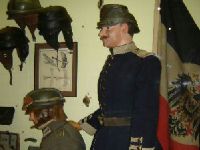 Seesoldat Uniform from Flanders (See Brussels Royal Army Museum Page) Musée Royale de l'Armée Collection 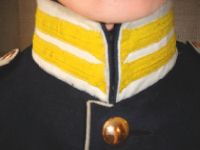 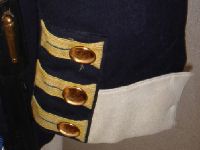 Details of the collar and cuffs (See Seebataillon Blue Uniform Page) Photo Copyright Doppler |
||
| Figure 3 is based on a
wartime photograph of a Officer of the 1st Naval Infantry Regiment
taken in Flanders in 1914. He wears an officers pattern greatcoat. It was
light grey, double breasted with six brass buttons on each side and had
the same scalloped skirts at the rear with three brass buttons and white
piping as the tunic had (see right). The collar of the officers greatcoat was dark
blue, but the inside was white which showed as a lapel when the greatcoat
was worn with the first button open across the chest. The greatcoat
has officers shoulder straps (with the imperial crown but without the anchor and
battalion numeral) in silver braid showing his rank. There were in fact
two distinctive types of officer's greatcoat worn by the Seebataillone.
They were both similar except that the on M1898 model the two rows of
buttons down the front widened out towards the top and on the M1900 model
the rows of buttons were closer together and parallel. The officers tunics were same as those of the other ranks but usually privately tailored of higher quality, again with officer's shoulder straps. Officers' collars were higher, the fit was better and yellow Litzen were replaced by gold lace. Similarly the officers shakos were of higher quality with better fitting covers. Officers did not wear the unit number on the front of the shako cover. |
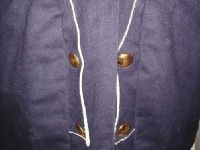 Rear skirts detail (See Seebataillon Blue Uniform Page) Photo Copyright Doppler |
||
Figure 4 is based on a wartime photograph of a Seesoldat of the Naval Infantry Division taken in Flanders about 1916. He wears the field grey M1910 uniform which was authorised for the Marine Infantry on 4th September 1914 but it did not replace the blue uniform overnight. The blue uniform was eventually withdrawn from service by an order of 1st March 1915. Aside from being in less conspicuous field grey it was very similar to the old dark blue uniform except it had a stand and fall collar, the collar and cuffs were only piped in white not fully white and the dull brass buttons bore the imperial crown (later in the war these buttons were made of cheaper metals). The shoulder straps were field grey, piped in white with an imperial crown, anchor and battalion numeral in yellow (see below). The matching trousers were also field grey and piped in white. This figure is not wearing the cover for his shako. Unlike early war shakos made of black leather, later shakos were made from leather, felt or cloth covered felt in a variety of shades from green to khaki (see right and below right). Similarly the once bright brass imperial naval eagle was later made of duller metals of various colours. This figure still carries the old pattern M1898 blackened leather equipment. |
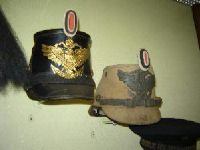 Two Naval Infantry Shakos (See Brussels Royal Army Museum Page) Musée Royale de l'Armée Collection |
||
|
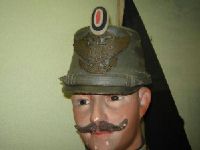 Another Naval Infantry Shako (See Brussels Royal Army Museum Page) Musée Royale de l'Armée Collection |
||
| Figure 5 is based on a
wartime photograph of a NCO of the Naval Infantry Division in taken
in Flanders between 1915-18. He again wears the field grey M1910 uniform
piped in white, with NCOs lace in on his collar and cuffs. He wears an
NCOs or Officers peaked field cap in field grey with white piping and
hatband. This field grey cap replaced the similar old blue field cap (see right)
with the introduction of the M1910 uniform. Peakless field caps, first in blue and later in grey, with white hatbands and
piping were worn by other
ranks. This NCOs belt is in blackened
leather and typically for later in the war has a dull grey one piece belt buckle. Figure 6 is based on a wartime photograph of a Seesoldat of the Naval Infantry Division taken in Flanders in 1918. The army's 1915 field grey tunic was authorised for the Marine Infantry from 10th June 1916. As slowly as they had started to receive the M1910 uniform, the Naval Infantry began to receive the new M1915 uniform. It was common to see different men of the same unit wearing M1910, M1910 modified (with simplified cuffs) and M1915 tunics together. For the Naval Infantry the M1915 tunic retained the double gold Litzen on the collars but lost all piping. The shoulder straps were of white with the old crown, anchor and unit numeral in yellow. This figure wears an M1916 steel helmet and slate grey trousers without white piping. Despite these updates he still caries the old style M1898 pattern ammunition pouches in blackened leather. |
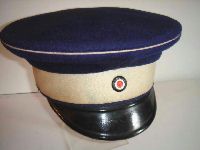 Blue Seebataillon Peaked Cap (See Field Cap Details Page) Photo Copyright Doppler |
||
|
Please email me here if you have more information or photos on this topic. |